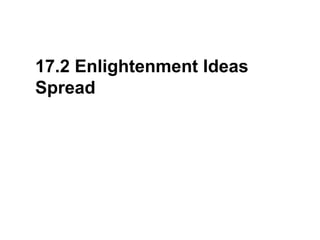
17.2 enlightment ideas spread
- 2. As Enlightenment ideas spread across Europe, what cultural and political changes took place?
- 3. Background: The Enlightenment brought cultural changes as writers, artists, and musicians spread new ideas. Even absolute monarchs in Europe granted greater freedoms in their realms to become enlightened despots.
- 4. From France, the heart of the Enlightenment, ideas spread across Europe and beyond. These new ideas created challenges to the rulers of the day. People saw that reform was necessary to achieve a just society.
- 5. • censorship – restrictions on access to ideas or information Most government and church authorities felt they had a sacred duty to defend the old order. The most common defense was through censorship of writers and books. Writers fought back by disguising their ideas in fiction. Voltaire’s Jonathan Swift’s Montesquieu’s Candide Gulliver’s Travels Persian Letters exposed satirized eighteenth- mocked French corruption century England. society. and hypocrisy.
- 6. • salons – informal social gatherings at which writers, artists, philosophes, and others exchanged ideas Ideas spread through salons as well as books and pamphlets. In the 1600s a group of noblewomen in Paris began inviting a few The most respected friends to their homes salons hosted for poetry readings. writers and By the 1700s, some musicians such as middle-class women Diderot and Mozart. began holding salons as well.
- 7. • baroque – ornate style of art and architecture popular in the 1600s and 1700s The arts evolved along with the new ideas of the Enlightenment. • In the age of Louis XIV, courtly art and architecture were grand and opulent, reflecting the lives of saints or glorious battles. • This was the era of the baroque style.
- 8. • rococo – personal, elegant style of art and architecture made popular during the mid-1700s The court of Louis XV was much less formal, which was reflected in the rococo style. Artists moved away from heavy splendor to light, elegant, and charming subjects. This style was criticized by the philosophes as superficial, but it was very popular among the upper and middle classes.
- 9. As in art, music evolved from baroque to rococo to the style known as “classical.” Johann • Created religious works for organ and Sebastian Bach choirs George Frideric • Wrote pieces for King George I, as well Handel as 30 operas Franz Joseph • Developed the string quartet and the Haydn symphony Wolfgang • Created operas, symphonies, and Amadeus Mozart religious music that defined the new style of composition
- 10. Literature developed new forms and readers by the 1700s. • Middle-class readers liked stories about their own times told in straightforward language. • Thus began an outpouring of novels, long works of prose fiction. • Robinson Crusoe, by Daniel Defoe, was an exciting tale about a sailor shipwrecked on a tropical island.
- 11. • enlightened despot – an absolute ruler who uses power to bring about political and social change • Frederick the Great – king of Prussia from 1740 to 1786, an enlightened despot • Catherine the Great – became empress of Russia in 1762; believed in the Enlightenment ideas of equality and liberty • Joseph II – the most radical of the enlightened despots; ruled Austria and worked for religious equality and an end to censorship Absolute monarchs who adopted or accepted Enlightenment ideas were known as enlightened despots. Monarchs who applied enlightened ideas to their governments included: • Frederick the Great of Prussia • Joseph II of Austria • Catherine the Great of Russia
- 12. The ideas of the philosophes spread to the ruling classes and convinced some of them that reform was necessary. Frederick the Great (Prussia) Joseph II (Austria) • Reduced use of torture • Modernized • Allowed a free press Austria’s • Tolerated religious differences government • Supported religious equality for Catherine the Great (Russia) Protestants and • Abolished torture Jews • Established religious tolerance • Ended censorship • Granted nobles a charter of rights • Abolished serfdom • Criticized the institution of serfdom
- 13. Although these rulers implemented reforms, they would not give up their own power. • Frederick the Great desired a stronger monarchy and more power for himself. • Catherine the Great refused to give up power but greatly expanded the Russian empire. • Joseph II implemented many changes, but most were canceled after his death.
- 14. • By the late 1700s Most Europeans’ ideas about equality lives were untouched and social justice by the enlightened reached peasant cultural movements. villages. • These ideas sowed the seeds for the political upheaval of the 1800s.
- 15. As Enlightenment ideas spread across Europe, what cultural and political changes took place? They contributed new ideas such as separation of powers and freely elected government.
